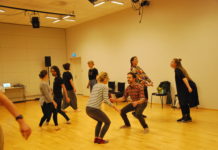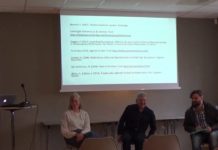Delegates at the 9th International Drama in Education Research Institute were treated to an abundance of exciting and engaging practical workshops during the 7-day event. To give you a flavour of what was on offer, the Dialogue team have put together a series of toolkits that include the workshop abstracts, biographies of the workshop leaders, and featured activities. It’s important to note that these activities are by no means comprehensive of the overall workshops but merely represent a small portion of the activities being introduced to participants.
Teaching Playwriting: Creativity in Practice
Facilitated by Paul Gardiner (Australia)
“Emanating from recent research in playwriting pedagogy and creativity, this workshop will introduce participants to a new approach to teaching students how to write for the theatre. The workshop will introduce participants to the ‘Playwright’s wheel’ which outlines the many access points for starting young people on the journey of writing a play. It will provide theoretical and practical ideas to increase students’ ability to find their voice, explore their ideas in dramatic form and develop key playwriting skills. It will also demystify the process for teachers and students, providing accessible structure and strategies to scaffold and support the students in their creative work. The session will focus particularly on the place of collaboration and idea sharing through a workshop approach to creativity.”
Paul Gardiner lectures in creativity and drama education in the Sydney School of Education and Social Work at the University of Sydney. He was an Ewing Postdoctoral Research Fellow in the School from 2015-2016 and is currently exploring the impact of creativity theory on teaching and learning in the arts. Paul is particularly interested in the interconnected concepts of knowledge, creativity, agency and engagement. He is also currently working on developing an interdisciplinary course in the Faculty of Arts and Social Sciences. Paul was Chief Examiner for NSW HSC Drama and was Director of Research on the Drama Australia Board 2015-2016. He is an experienced Secondary Drama and English teacher, having established and led successful Drama departments. He continues to deliver professional learning workshops for teachers and creative writing workshops with students and is currently writing a book on teaching playwriting and creativity, to be published by Bloomsbury/Methuen Drama UK.
*For a comprehensive understanding of Gardiner’s activities demonstrated in this workshop, refer to his book on teaching playwriting and creativity, to be published by Bloomsbury/Methuen Drama UK. Expected to be available from March 2019.*
Featured Activities:
Activity 1 – The Structure of a Scene
- Explain the structure of a scene through the metaphor of a bowl of apples. Gardiner – “Writing a scene is the bread and butter, it’s the first thing you need to do when writing a play […] So what is a scene? A scene is a bowl of apples.
 A scene starts with too many apples in the bowl, they are precariously balanced on the top […] then something happens, in this case the bowl of apples is knocked over and there is a multitude of consequences […] the rest of the play is putting the apples back in the bowl, everyone wants to return the thing to how it was […] once they are all back in the bowl notice they are all bruised. The world is changed by something that has happened in the scene, it can’t just go back to the first image, it has to be changed […] every scene has to take us from A to B.”
A scene starts with too many apples in the bowl, they are precariously balanced on the top […] then something happens, in this case the bowl of apples is knocked over and there is a multitude of consequences […] the rest of the play is putting the apples back in the bowl, everyone wants to return the thing to how it was […] once they are all back in the bowl notice they are all bruised. The world is changed by something that has happened in the scene, it can’t just go back to the first image, it has to be changed […] every scene has to take us from A to B.” - Instruct participants to stand up, clear the room, and walk around the space. Ask them to move at a certain speed (e.g. 6 out of 10).
- Peanut Butter Game – The floor is the toast, the participants are the peanut butter. Gardiner – “I hate any piece of the bread not having any peanut butter on it, so you have to make sure there are no gaps on the floor – spread yourselves out nice and evenly.”

- The group should try and keep moving at the same speed as each other.
- As participants are walking, explain the next step of the activity.
- Gardiner – “In a minute we are going to create a scene. It’s going to be a place and you are going to find your own role in the scene, no directing other people, just find your own position. Now, I would like you, as a group, to create a scene of a bank. So, watch where other people are, find out where your space is, find out where you make sense, find a role that hasn’t been taken.”
- This first freeze frame image is the “full apple bowl”.

- Instruct participants to remember this freeze frame and their position/role in it because they will return to it in a moment.
- Now ask the participants to walk around the space again. Gardiner – “what we are going to do now is have the exact same bank after an event. I don’t know what that event is, you tell me what that event is, okay go.”
- Remind participants to move into a second freeze frame of the event/complication without talking.

- Instructed to remember this second freeze frame, participants should move around the space once more.
- Gardiner – “Now what’s the natural conclusion to that scene? We’ve had the precarious balance (bowl of apples), the event, now we want to have this new balance, the new status quo. Okay move into the new balance, find out what’s happened now”.

- Instructed to remember this third freeze frame, participants should move around the space again.
- Gardiner instructs while they walk, – “I am going to say 1, 2, 3. You are going to move into each image, the opening balance, the event/complication, and the resolution. Okay, ‘1’ [Participants move into image 1, freezing momentarily], keeping your spatial awareness so you know where everyone is. Now as you move to 2 you’re going to move in slow motion, stylistically. Okay, 2′ (participants slowly move into image 2, holding the image momentarily), ‘and 3’ (participants slowly move into image 3), and relax.
Comments from the Workshop Leader…
“Some of the subtle moments are actually where the real learning happens. So, for example, there were those three moments [the three frozen images] that clearly show that there has to be progression and change [in a scene]. But also, when I asked you to do it slowly, there actually has to be some way to get from one part to the other which is the dialogue or, in other words, action. Stuff has to happen to get from one place to the other.”
“I use this activity when teaching young people. The actual words of a play are not just what a play is, in its entirety […] it’s the whole scene that’s important, the action.”
Activity 2 – Characters in Action in Situations

- This begins as an individual writing activity.

- Ask participants to divide their page into three columns.
- In column 1, they should write a list of names down the page – as many as they can in one minute (but at least 25).
- In column 2, they should write a list of places – again, as many as possible within a minute. These should be specific places where stuff happens, not just countries or cities i.e. a bedroom, a garden shed, an ice-skating rink.
- In column 3, they should write a list of objects for another minute. These can be any object – even a ridiculous random objects.
- If time permits, they can do the same in a fourth column for ‘actions’.
- Now circle the 4th ‘name’ on your list, the 6th ‘place’ and the 2nd ‘object’. Write the three words on the bottom of your page.
- Now they have 30 seconds to imagine, not write, a situation in which these three words make some sense together. It can be ridiculous but it must make sense in some way.
- In groups of three ask participants to share and discuss their imagined scenario with each other. To help them ask questions about their scenarios, they should follow the following ideas:
- Ideas that inspire them to want to know more – Who was that character? What was that idea? Where will they go?
- Ideas that inspire new or imaginative thoughts in them – when you said ‘X’ it made me think of ‘Y’ – or that makes me think of…
- Ideas that spark connections between them – images, texts (allusions or inspirations), links to existing art or phenomena.
- “You never get to say I like it or you never get to say I don’t like it”, recommends Gardiner.

- The person sharing the scenario can take or leave whatever new ideas they are offered by their group.
- Gardiner – “This group now becomes your writing workshop group. You write for the other two people in your group who will perform your scene. You write and direct for a two-person play […] Everyone is acting and writing, everyone is involved the whole time”.
Comments from the Workshop Leader…
“I think workshopping and collaborating is best when generating and creating”
“It’s about enabling and equipping students to be making choices themselves”










